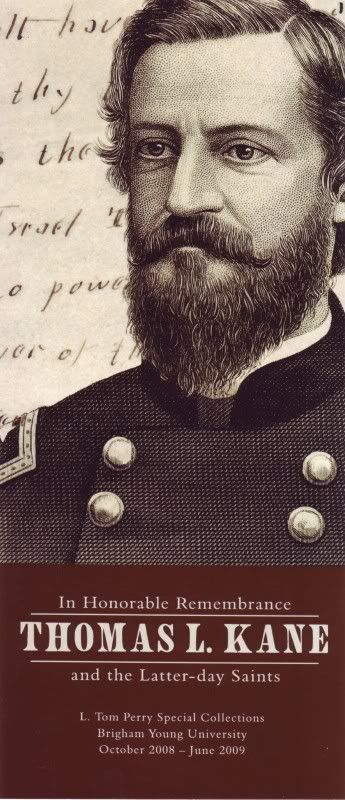 David J. Whittaker, BYU’s curator of 19th Century Western and Mormon Manuscripts and guiding spirit behind BYU’s lecture series “In Honorable Remembrance: Thomas L. Kane and the Latter-day Saints,” reminds interested members of the public that the next lecture will be given this coming Wednesday. He writes,
David J. Whittaker, BYU’s curator of 19th Century Western and Mormon Manuscripts and guiding spirit behind BYU’s lecture series “In Honorable Remembrance: Thomas L. Kane and the Latter-day Saints,” reminds interested members of the public that the next lecture will be given this coming Wednesday. He writes,
It will be presented by Edward A. Geary, 11 February, at 3 pm in the HBLL Auditorium. Dr. Geary will be discussing “Tom and Bessie Kane and the Mormons.” Edward Geary is well known to the BYU audience, having served as a Professor of English from 1968 to his retirement in 2006. He also served as the Editor of BYU Studies, as the Director of the Charles Redd Center for Western Studies, as Chair of the Department of English and as Associate Dean, College of Humanities. He has served as a board member and executive member of the Utah Arts Council and as the president of the Association for Mormon Letters. He received his Ph.D. in English Literature from Stanford University, having earlier received his BA and MA from BYU. His writings, in addition to numerous articles, include Goodbye to Poplarhaven: Recollections of a Utah Boyhood (1985); The Proper Edge of the Sky: The High Plateau Country of Utah (1992), and A History of Emery County (a volume in the Utah Centennial County History Series, issued by the Utah State Historical Society, 1996).
Dr. Geary’s Kane lecture will provide a closer, more personal and literary look at Thomas and Elizabeth Kane. They referred to each other as Tom and Bessie in their personal relations, a relationship that enjoyed a remarkably close and mutually supportive marriage (when they were married in 1853, she was 16 and he was 31). For Bessie, a pious Presbyterian, Tom’s long devotion to and sacrifices in the interests of the Latter-day Saints constituted a painful trial, almost like a third party to their marriage. She only came to terms with her feelings toward Brigham Young and the Latter-day Saints and to more fully appreciate their profound regard for her husband, during the visit of the Kanes to Utah in the winter of 1872-73, a visit she had agreed to reluctantly but concluded with a week-long stay at Brigham Young’s Lion House, “as a public testimony . . . that my opinion of the Mormon women has so changed during the winter that I was willing to eat salt with them.”
Both of the Kanes produced important literary studies of Latter-day Saint society. Tom’s expanded 1850 lecture, “The Mormons,” was designed to reshape national attitudes toward the driven Latter-day Saint refugees. However, its greater long-term effect has been on the Saints themselves. Many of the popular images of the expulsion from Nauvoo and the social organization of the Camps of Israel on the Missouri River can be traced to Thomas Kane’s descriptions. Elizabeth Kane’s Twelve Mormon Homes, published in 1874, and the journals she kept during their seven-week stay in St. George together represent the most interesting and insightful traveler’s account of the nineteenth-century Latter-day Saint society that we possess.
Reserve time before or after the lecture to visit the outstanding display of Kane documents and artifacts owned by BYU and exhibited in the space at L. Tom Perry Special Collections, just a few steps from the lecture auditorium.
See reviews of two previous lectures in this series given by Bill MacKinnon and Ben Bennion/Tom Carter.
Continue reading at the original source →



